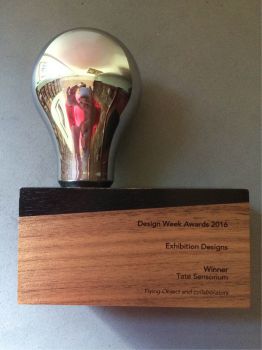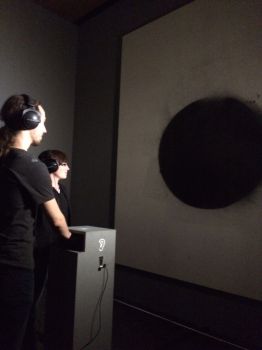Major design award for multi-sensory art experiment
By: James Hakner
Last updated: Wednesday, 22 June 2016

The 2016 Design Week award for 'Exhibition Designs' awarded to the creators of Tate Sensorium, Flying Object and collaborators. Photo credit: Flying Object

Damien Ablart (PhD student) and Dr Marianna Obrist (Head) of the SCHI lab demonstrate their contribution to Tate Sensorium, using touch and sound to provide visitors with a new way of experiencing Full Stop (1961) by John Latham.
A multi-sensory art experience at Tate Britain involving University of Sussex academics has won a major design award this week.
Tate Sensorium, which saw creative agency Flying Object commissioned by Tate to “connect the world with art”, has won in the exhibition category of the 2016 Design Week awards – the leading accolade in the design industry.
Dr Marianna Obrist and her team in the Sussex Computer Human Interaction (SCHI) lab used their expertise on haptics – technology that stimulates our sense of touch – to help create the award-winning experience last summer.
Four paintings from the Tate collection were each paired with combinations of stimuli to taste, smell, hear and touch.
The Sussex team – Dr Obrist (SCHI lab team leader), Damien Ablart (now a PhD student in the team) and Dr Carlos Velasco - worked alongside a sound engineer, a master chocolatier and a perfumist to create the installation.
The 2016 Design Week judges said: “This is a game-changer for experiencing art exhibitions in its use of science and technology. It’s a pathway for the next 100 years in exhibitions.”
Tate Sensorium came about after Flying Object's original concept won the IK Prize 2015, awarded annually for an idea that uses innovative technology to enable the public to discover, explore and enjoy British art from the Tate collection in new ways.
By programming and installing a piece of technology developed by Ultrahaptics, the team were able to use ultrasound to create patterns of air on the palms of Tate visitors.
Tony Guillan, Producer (IK Prize) at Tate, said: "We are thrilled that Tate Sensorium has been recognised with this prestigious award.
"The exhibit attracted diverse new audiences to Tate Britain by testing a truly innovative way of experiencing artworks in a museum setting.
"It was a pleasure to work with Flying Object and their team of collaborators including Dr Marianna Obrist at the University of Sussex, whose team conducted research into the impact of haptic sensations on visitors’ experiences. A great deal was learnt about how sensory stimuli can influence the way we look at works of art."
Dr Obrist is part of a rapidly growing body of researchers who are unravelling the surprising impact our neglected senses have on the way we feel and think. She is just over a year in to a five-year project, funded by the European Research Council, to explore the multisensory technologies of the future.
Dr Obrist said: “This is an incredibly exciting area of research and we are just at the beginning of this journey studying touch, taste, and smell for interactive technologies.
“Our findings so far have shown that haptic technology can evoke specific emotions by stimulating particular parts of your hand.
“Taste and smell is a bit behind touch technology-wise, but we still have some exciting projects on the go.
“The future of entertainment is in technology that engages all your senses. The way that we experience TV, cinema, games, galleries, museums and so on is going to be very different in 10 years’ time.”
